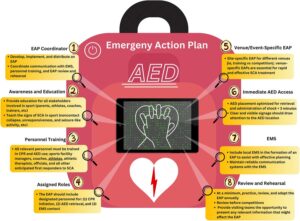Sudden cardiac arrest (SCA) is the leading cause of death in young athletes during sports and exercise in the U.S. Although emergency plans and access to defibrillators (AEDs) have improved, survival trends have not been well understood. A new observational study, recently published in the Journal of the American College of Cardiology (JACC), helps explain how survival has changed—and who’s most at risk.
How the Study Was Done
Researchers tracked cases of sudden cardiac arrest (SCA) and sudden cardiac death (SCD) in young athletes across the U.S. over nine years, from mid-2014 to mid-2023. The study included athletes aged 11 and up who were playing at the middle school, high school, college, club, or professional level, as well as those who had recently stopped competing (within the past year). The study was conducted in partnership with the National Center for Catastrophic Sports Injury Research.
Researchers collected information from news reports, athlete databases, and direct reports. They reviewed each case to determine if it was a sudden cardiac arrest (SCA), where the athlete collapsed and survived after resuscitation, or a sudden cardiac death (SCD), where the athlete did not survive. Medical records and details about the event helped determine the cause and whether it happened during exercise or while at rest. The researchers then looked at survival rates based on factors like race and whether the event was related to physical activity.
Main Findings
- Over the 9-year study period, 641 young athletes experienced sudden cardiac arrest (SCA). The average age was 17, and 85% were male.
- Overall survival was 49% (315 of 641 athletes).
- Survival was higher during exercise, at 57% (275 of 481 cases).
- Survival rates improved over time, reaching 72% for exercise-related SCA in the final year (2022–2023).
- Athletes who had SCA during games or competitions were more likely to survive (70%) than those who collapsed during practice or training (53%).
- Significant racial disparities were found, even after adjusting for other factors:
- Black athletes were 63% less likely to survive than White athletes.
- Athletes identified as “Other race” (including Hispanic/Latino and Asian) were 69% less likely to survive than White athletes.
- SCA that happened at rest or during sleep had a much lower survival rate (27%), likely because these events were less often witnessed.
- Among cases where a cause could be determined, the most common causes of SCA/SCD were:
- Hypertrophic cardiomyopathy (20%)
- Congenital coronary artery abnormalities (13%)
- Possible cardiomyopathy (11%)
What the Findings Mean
The increase in survival rates is a positive sign and likely reflects better emergency planning at sports events, such as quicker recognition of SCA, faster CPR, and easier access to defibrillators (AEDs).
Survival was higher during games, possibly because more people are nearby to help, including medical staff and fans, and AEDs are more likely to be available. In contrast, practices may not have the same level of support. SCAs that occur during rest or sleep are often unwitnessed, which can delay life-saving care.
The racial differences in survival are concerning. Black athletes not only face a higher risk of SCA/SCD but are also less likely to survive. These gaps are likely due to social and structural factors, such as unequal access to emergency resources or differences in school and community funding—not biological differences. Earlier studies also show that Black and Hispanic individuals are less likely to receive CPR from bystanders.
Moving Forward
Survival is improving, but there’s still more to do, especially during practices and in communities with fewer resources. Every sports setting should have a strong emergency plan, with CPR training and fast access to AEDs.
Some sports, like football and swimming, may need extra focus, since athletes in these groups had lower survival rates. The racial gap in survival also points to the urgent need for more research into how social and economic conditions affect emergency response and outcomes.
The bottom line: Progress is being made, but giving every athlete an equal chance to survive, no matter their race, sport, or where they play, will take continued work in education, access, and equity.

The UBC Division of Cardiology appreciates Dr. Moulson and the Sports Cardiology team for their outstanding contributions and ongoing leadership in the field.
For more info check out: SportsCardiologyBC | https://sportscardiologybc.org/
Reference
Petek BJ, Churchill TW, Moulson N, et al. Survival outcomes after sudden cardiac arrest in young competitive athletes from the United States. JAMA Cardiol. 2024;9(4):386–395. doi:10.1001/jamacardio.2023.6420
Moulson N, Wiese J, Petek BJ, Mitchell R, Isserow S, McKinney J. Comprehensive Prevention of Exercise-Related Sudden Cardiac Arrest or Death. Can J Cardiol. 2025;41(3):549-552. doi:10.1016/j.cjca.2024.11.014